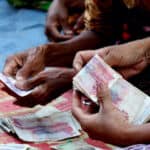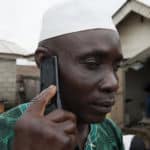Right Decision, Wrong Reasons: The Way Forward from the Attack on Global Aid
The liberal international order is fracturing. The three pillars of the post–Cold War era — multilateralism, democracy and free trade — are under sustained pressure. From Ukraine to the Sahel, we’ve seen how diplomacy is being bypassed in favor of bilateral investment and transactional alignment.
The vacuum of coordinated global leadership is real and growing, and it’s one we’ve encountered firsthand in our work across the humanitarian sector in climate-affected regions.
One part of that collapsing framework is the attack on the global aid system, which has profound implications for the roughly 4 billion people who live on less than $7 a day — and especially for the 120+ million who have been forcibly displaced from their homes. These attacks have come from numerous angles, from populists who want to slash international spending due to perceived waste, to critics who argue that aid entrenches dependency and corruption, defeating the purpose.
While these critiques are overly simplistic, they point to a real issue: The humanitarian aid system has failed to evolve. It is structurally incapable of catalyzing the kind of long-term economic transformation displaced communities need.
As individuals who have spent our lives enabling and advocating for assistance for the most vulnerable populations, we’ve seen how humanitarian response structures have actively stifled the very innovation needed to meet current development challenges.
In many of the refugee-hosting communities we’ve worked in, which are often located in the most climate-stressed regions on the planet, humanitarian aid systems still resemble planned economies.
Goods are distributed, not sold. Jobs are donor-funded and temporary. Private enterprise is often restricted, and refugees are either barred from working or offered “incentive jobs” that pay a small stipend, often far below minimum wage, and are typically not recognized as formal employment.
As a result, international NGOs dominate a procure-and-distribute ecosystem that treats people as beneficiaries rather than as consumers or producers. Procurement policies prioritize donor compliance over local demand. Vocational training programs rarely lead to jobs. Investment is mostly an afterthought.
There may once have been enough aid money to prop up this kind of system. In the aftermath of USAID’s demise and the global reduction in aid budgets, that’s no longer the case. The future demands a shift toward market-responsive systems built by actors with capital, agility and a long-term stake in success, especially in places where traditional aid is receding.
Finance Is Plentiful, But Systems Are Inadequate
We’ve seen how localization efforts in the humanitarian aid sector often stop short of structural change. Instead of transforming how the system operates, they simply shift delivery responsibilities to local groups, while preserving the same outdated logic at the core.
The real challenge isn’t a lack of technology or money, it’s the system itself. Private investment funds — including private equity, venture capital and other private market vehicles — already manage nearly $12 trillion globally, and are projected to exceed $18 trillion by 2027. That figure doesn’t include the $11.5 trillion managed by sovereign wealth funds as of 2023.
These pools of capital are actively seeking long-term opportunities in infrastructure, energy access and climate resilience, the very sectors most critical in displacement-affected regions. But capital doesn’t flow into broken systems. Most investors don’t view these regions as investable, not because the opportunities don’t exist, but because the aid system has failed to support, or even advocate for, the legal, financial and institutional foundations that investment depends on. While national governments hold ultimate responsibility, international actors shape this enabling environment: through the policies they promote, the partnerships they prioritize and the systems they choose to fund.
Until local ecosystems can demonstrate scalable, measurable and commercially viable models, private investment will remain limited to niche or philanthropic ventures. And even subsidized, blended finance structures are failing to scale investment into high-risk or fragile markets: In 2023, the non-sovereign arms of multilateral development banks — including the World Bank’s IFC — mobilized just $0.64 in private finance per public dollar, far short of their $6-per-$1 target.
Meanwhile, OECD countries spent $29 billion on refugee and asylum-seeker support — within their own borders. This reflects a broader imbalance, in which wealthy nations are investing heavily to manage displacement at home, while doing little to build investable systems in the regions where most refugees actually live. The result is that displacement-affected economies remain locked in dependency, not because opportunity is lacking, but because the architecture to attract capital simply doesn’t exist.
Yet viable, market-based alternatives do exist. Public-private partnerships are beginning to unlock investable models in essential services, including energy access, in low-income countries more broadly. In off-grid regions, for instance, solar mini-grids have demonstrated strong returns under the right conditions. While adoption and financing challenges remain, especially in displacement contexts, these emerging models point to a broader truth: When products are designed for users, not just donors, market demand can and does emerge.
A Market Model Is Emerging
Despite the barriers, we’re beginning to see models that take a different, market-based approach. In the fragile and crisis-affected regions where we work, early movers are laying the foundations of future economies.
Organizations like Last Mile Climate don’t deliver aid or run projects — they build systems. Through their Climate Action Partnerships, they align communities, firms, public actors and climate finance to make refugee-hosting regions investment-ready, enabling them to overcome complex challenges like clean cooking. These partnerships recognize displaced people as economic actors: as workers, entrepreneurs and consumers.
In this ecosystem approach, private firms sell goods and hire talent, governments address legal bottlenecks and refugee-led organizations take the lead on mobilizing communities. INGOs and other humanitarian actors transition from service providers to conveners and enablers.
A key part of this market-oriented shift is rethinking how to work with the UN system. Rather than engaging only with humanitarian agencies in its humanitarian work, Last Mile Climate works to integrate displaced populations into the mandates and work plans of climate and environment agencies at the national and global levels. This means linking with technical bodies, climate finance accreditation processes and policy frameworks that are normally out of reach for humanitarian-focused agencies.
In Uganda, Climate Action Partnerships — co-led globally by Last Mile Climate and UNEP, nationally by Mercy Corps and FAO, and locally by refugee-led community organizations — aim to align refugee inclusion with energy and environment ministries and national adaptation and mitigation plans. This enables access to technical expertise, networks and climate finance channels that would otherwise bypass these communities. By breaking out of humanitarian silos, it is possible to unlock the resources, capacity and legitimacy that are essential for long-term investment readiness.
To us, this is what real localization looks like; not simply reassigning delivery roles, but fundamentally redesigning the model to foster sustainable, inclusive economic development.
This isn’t development as usual: It’s market formation in real time, and it’s urgently needed.
Five Principles for a Post-Aid Economy
Based on our experience, we propose five principles to guide the transition from the failing aid model toward something that can actually deliver resilience and dignity:
- Design for systems, not projects: Build the legal, financial and operational infrastructure that allows market activity to scale and sustain itself.
- Default to cash: Cash-based aid stimulates demand and allows people to make their own decisions. In-kind aid should be rare, and when used, it should be sourced locally to strengthen economies.
- Back businesses: Donor structures tend to reward nonprofit creation, flooding regions with NGOs while ignoring or sidelining local businesses that could deliver more durable solutions.
- Ease legal and financial access: The right to work, access credit and have freedom of movement beyond restricted settlements or camps is fundamental for economic participation and human dignity.
- Build scalable platforms: Evolve past the model of fragmented donor projects to prioritize collective collaboration and investment platforms, where fostering the local market and supporting inclusive labor practices are seen as fundamental pathways for progress.
None of this can succeed without acknowledging the political realities of host countries. Refugee hosting is often framed as a global public good, but low-income states understandably expect compensation or tangible benefits for assuming this role.
In practice, policy reforms that enable refugees’ economic inclusion — such as easing work rights or opening access to finance — are negotiated within a broader context of national development plans, electoral politics and fiscal priorities.
Additional private investment in refugee-hosting regions can be one form of compensation, but to be effective it must be clearly additional to, and aligned with, wider economic initiatives supported by multilateral development banks or national growth strategies.
Without this, efforts to expand economic inclusion or build infrastructure in refugee settings risk being seen as competing with, rather than complementing, host country objectives.
From Humanitarian Relief to Economic Inclusion
When planned economies collapse, markets emerge in their place. We believe the humanitarian aid system is now at an inflection point, as its planned-economy structure — weakened by years of inefficiency and dependency — is now aggressively dismantled by external pressures.
Recent funding freezes, shifting geopolitical priorities, and the diversion of aid budgets toward domestic and defense spending have accelerated a breakdown that was already underway.
If we work together, across sectors and silos, we can design systems that unlock enterprise, enable investment, and treat displaced people as agents of their own futures.
We’ve seen the costs of getting it wrong. Now is the time to get it right.
Simon Marot Touloung is a South Sudanese refugee, climate advocate and Head of the African Youth Action Network; Elana Banin is a policy expert in economic inclusion and displacement; Jakob Øster is the Founder and Executive Director of Last Mile Climate.
Photo credit: RadekProcyk
- Categories
- Investing



